Strawberry Wine is easy to make, whether from fresh or frozen strawberries. This Homemade Strawberry Wine Recipe will show you how!
Originally published August 18, 2020, Updated on 4/28/2023.
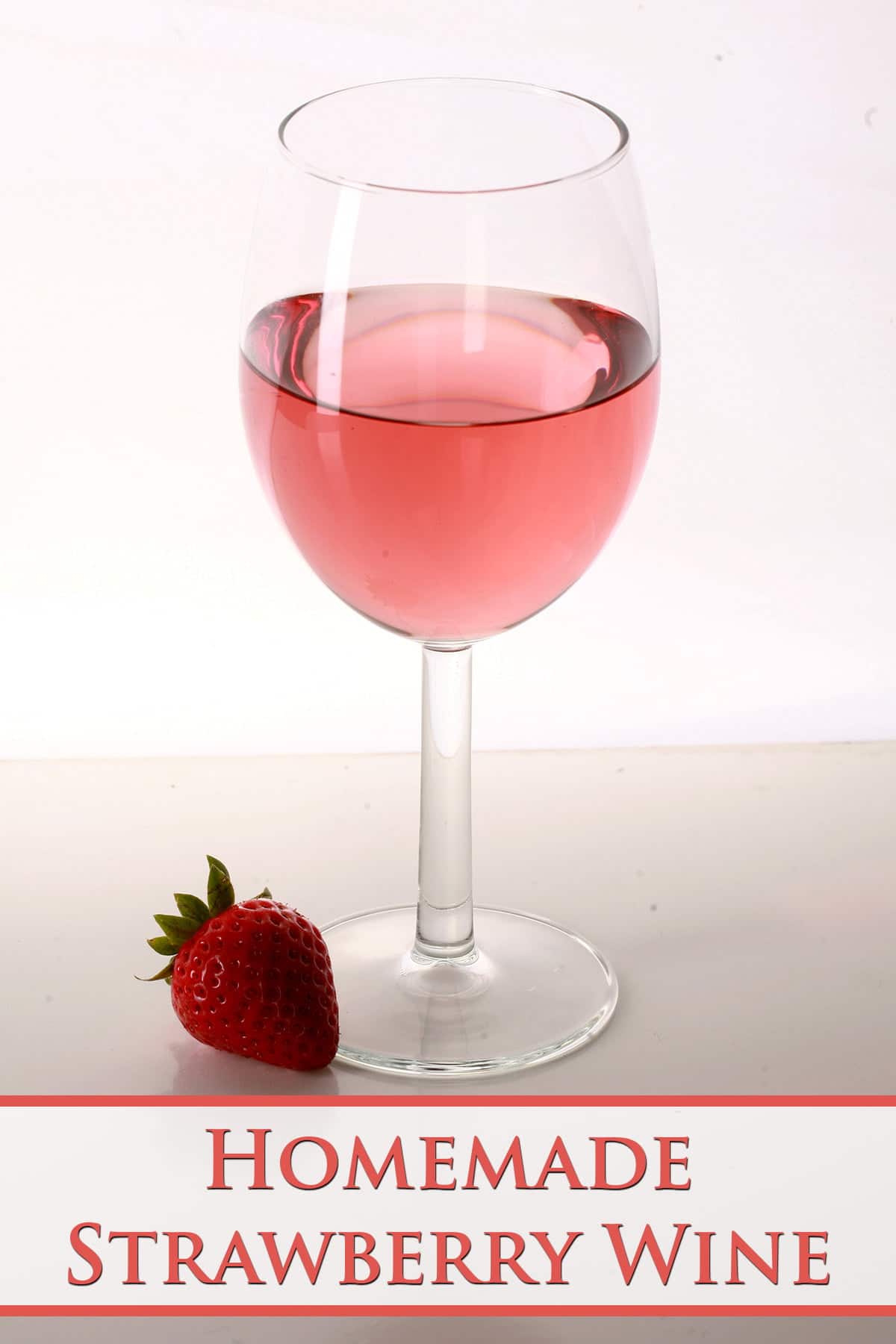
Not only are strawberries generally easy to come by - even outside of strawberry season - they make a delicious fruit wine.
It's also a great way to use up large amounts of strawberries. I'm sure we're not alone in having had those times when our desire to go berry picking resulted in WAY more strawberries than we'd be able to eat before they go bad!
Made right - IE as a sweet wine, NOT dry wine - homemade strawberry wine is fantastic!
While many wine drinkers may turn up their noses at a sweet wine, residual sweetness is definitely required to bring out the strawberry flavour.
Not really a red wine or white wine, strawberries make a pink, delicate wine. Especially in the summertime, this makes for a nice light dinner wine.
Add some water and yeast, and let it go through the fermentation process for a while, before you move the wine off the fruit and let it continue doing its thing.
Repeat a few times, put it in bottles, and let it age.
Aging is important - the wine you get when it first starts resembling wine is only technically potable.
As is the case with many alcoholic beverages, aging makes it smooth out and turn into something you'll actually LIKE drinking!
Also, a note: Because the entire process takes several months, I recommend starting a fresh batch of strawberry wine shortly after opening your first bottle of finished wine.

Strawberry Wine Recipe Ingredients
While you can technically make a batch of wine using only fruit, you’ll get a much better finished wine if you use some additional ingredients.
This homemade strawberry wine recipe uses few ingredients, but it's important to make them the right ones. Most importantly:
Strawberries
This recipe is very flexible in terms of what kind of strawberries you use. Pick your own strawberries - wild strawberries or commercial - fresh or frozen, organic strawberries, or... inorganic strawberries. (LOL)
You can use fresh or frozen strawberries, there are just a few differences in how to use them, and a few good things to keep in mind:
Fresh Strawberries
For the most flavorful wine, use ripe fruit. You’ll want to through to remove anything that's not ripe, is moldy, etc. (Ripe strawberries have much better flavour and sweetness than under ripe fruit.)
Hull them and discard the leaves/stems.
I like to chop the strawberries* and let them sit in sugar for a couple hours before starting on the wine making, as it - maceration - draws the strawberry juice out of the berries
* You can mash strawberries with a potato masher if you don’t feel like chopping them.
Frozen Strawberries
Choose frozen strawberries that do NOT have added sugar, as that will affect the recipe.
If you MUST use strawberries with added sugar, cut the recipe sugar by about 2 cups and cross your fingers!
You'll likely have to adjust sweetening after the fact anyway.
When using frozen strawberries - with or without sugar - you can skip the maceration process.
Freezing and thawing strawberries breaks them down in a way that ends up with a result similar to maceration.

Sugar
Type of Sugar
Use plain white granulated sugar - or cane sugar - as brown sugar could overpower the delicate taste of the strawberries with the molasses flavour.
Unlike many red wines, strawberry wine really needs to be a sweet wine, or it doesn't taste like much of anything.
Depending on how your yeast progresses, you will likely need to back sweeten it.
More on that in a bit.
Alcohol Content
Aside from flavour, there’s the matter of alcohol content.
Your wine’s final ABV will vary wildly dependent on a few things: The initial sugar content of the strawberries you use, how much sugar you add, and what kind of yeast you use (more on that in a bit)
Any amount of sugar will result in a higher alcohol content than making the same wine without sugar added.
Sugar - both in the base wine itself, and from the added sugars - is what feeds the yeast, the yeast eats up the sugars and gives off alcohol as the byproduct of that process.
More sugar = more food = more alcohol... to a point, anyway. About that...
Brewing Yeast
The type of wine yeast you use will impact the alcohol content of the final product.
Yeast organisms don’t have an *unlimited* capacity to process sugar into alcohol.
At some point, the environment they’re living in - the brewing wine - becomes too high in alcohol for the yeast to survive. They die off, the fermentation stops.
Different types of wine yeast have different tolerances for alcohol in the environment.
That is, some yeast will be able to survive higher amounts of alcohol in the wine, so they’ll continue producing it longer than some other types.
Some types of yeast will bring you to something like an 6-8% ABV, while others will let things run wild until close to 20% ABV.
It’s good to know what you have in mind, when you choose your yeast.
Note: I’m going to refrain from using brand names in this section, as what’s available varies wildly between suppliers and regions!
I know firsthand how frustrating this can be, so ask your local homebrew supply shop for recommendations based on what you’re looking for.
ABV “Rule of Thumb” Tips
As a general idea of what you should consider:
1. If you want a sweet wine with a low-ish ABV - without having to back sweeten it (more on that in a bit) - choose a yeast with a lower tolerance for alcohol.
2. If you’re looking for a dry wine with a low ABV, choose a yeast with a lower tolerance for alcohol, and don’t use a ton of sugar.
3. If you want a sweet wine with a high ABV, use a bunch of sugar with a high-tolerance yeast... and be prepared to backsweeten it.
4. If you want a dry wine with a high ABV, use a fair amount of sugar and a high tolerance yeast.
If you want to know the actual ABV you arrive at, you’ll want to take specific gravity readings along the way. At the very least, you need the reading from right before you add the yeast, and the final reading.
Supplemental Ingredients
Yeast Nutrient
Yeast Nutrient just helps the yeast do its thing, and is generally optional.
Acid Blend
While some old fashioned country wine recipes will use lemon juice, acid blend is a powdered acid product, used to regulate the acid level in white.
This is for taste - without enough acid, the wine will taste kind of flat, and lacking in character.
If you don’t have acid blend, citric acid also works.
Pectic Enzyme
Pectic enzyme is used because of the technique we use - boiling water - to kill off natural yeast and bacteria.
Boiling or simmering fruit activates the pectin in it - this is how you make jam. When it comes to wine making, that pectin can lead to cloudy or hazy wines.
Pectic enzyme breaks down the fruit pectin, to prevent this.
Wine Tannin
Wine Tannin is a component of grape skins, which gives wine part of its character. It imparts a sort of bitter, astringent mouth feel to wine, and makes wine... taste like wine.
If you think about the difference between red wine and white wine in that sense - red wine has a lot more tannin than white.
Anyway, we use a touch of it in this wine, to round it out a bit and make it taste more like a “proper” wine.
If you’re not a fan of tannin, you can definitely skip it.
Wine stabilizer(s)
Wine stabilizers - such as sodium bisulfite or potassium sorbate - are used at the end of the fermentation, to STOP fermentation.
This can be a safety issue - wine that continues to ferment after bottling will pressurize the bottle, and the bottle can explode!
See my post How to Stabilize and Back Sweeten Wine for more information.
About Campden Tablets
When using fresh strawberries, some recipes will call for a campden tablet (sodium metabisulfite) and - usually - cold water.
This is a product made to inhibit the growth of wild yeasts, which are present on most/all fresh fruit.
This wild yeast is why you are able to make a wine product with nothing but fruit - the wild yeasts cause natural fermentation.
However, wild yeasts can also bring different flavors to your wine - and it’s not usually a good thing. Killing off wild yeasts is generally recommended.
This recipe uses boiling water instead of Campden tablets, though. While supplementary ingredients help, I do like to avoid them when it’s reasonable to do so!

Scaling this Wine Recipe
As a note, you can easily scale this wine recipe up - in fact, there's a function inside the recipe card itself to do the math for you!
For each gallon of wine, you’ll want to use about:
6 pounds of strawberries
3.5 pounds of sugar
1 gallon of water
All of the supplemental ingredients can be increased at the same rate
One note, though: You don't need to multiply the yeast, but the software doesn't know that. We will use one pack of yeast for anything from 1-5x batches, and then 1 pouch for every 5x batches beyond that.
As a related note: The recipe software is definitely geared towards cooking, not wine making.
Therefore, you can pretty much ignore all of the nutritional info it gives you: it’s calculated on everything that goes into the wine.
It does not take into account how much sugar will be fermented out, how much volume is lost to racking, the fact that the fruit pulp is removed before the final product, etc.

Equipment You’ll Need to Make This Wine
Large pot - for cooking the strawberries, water, and sugar.
2 gallon fermenter bucket and lid - this is the primary fermenter.
2 x 1 gallon glass carboys - I use one gallon carboys as the secondary fermentation vessel. 1 narrow neck gallon jug for the second round of fermentation, the other to rack it off onto for the next round of fermentation.
1 air lock and rubber stopper - To cap off the fermenters. These prevent contaminants from entering the wine, while allowing the carbon dioxide to escape.
Siphon, siphon tubing - for racking the wine from one fermenter to the other, leaving the sediment behind.
Nylon straining bag - Optional. If you’d like a bit less pulp to deal with when racking off the primary fermentation container, you can pour the cooked strawberry mixture into a brew bag and tie it off.
We don’t bother, personally.
Back Sweetening Your Strawberry Wine Recipe
Sometimes - usually, even - you’ll find that the yeast went a bit too far with their smorgasbord, and you end up with a strawberry wine that’s not as sweet as you’d like it.
... and that’s when you back sweeten it!
You can read my How to Stabilize and Back Sweeten Wine post for information on how to back sweeten it.

How to Make this Strawberry Wine Recipe
Now that I've gone into one of the late-stage aspects of wine making, let me backtrack and address the basics!
If you haven't attempted making wine before, don't be intimidated! Check out our primer to home brewing:
1: Wine Making At Home, Part 1: Why?
2: Wine Making at Home, Part 2: Equipment to Get Started
3: Wine Making at Home, Part 3: The Brewing Process.
4: Wine Making at Home, Part 4: How to Stabilize and Back Sweeten Wine
Just a small handful of entries, and you'll be good to go!
Wine Making Walk-Through
Full recipe follows, but here’s a walk-through and some additional tips on the process:
Prepare the Fruit Base
Rinse and pick through strawberries, removing any that are moldy, etc. Remove stems, chop or crush fruit.
Place in a large pot, along with the sugar. Using a potato masher or VERY clean hands, stir and mash strawberries. Let sit for an hour.
Add water to the mashed strawberries, stir well. Heat to ALMOST boiling, then simmer gently for 30 minutes.
Stir in acid blend, enzyme, nutrient, and tannin.
The next day, give the mixture a quick stir with a long, sanitized spoon, and – using sanitized equipment* – take a specific gravity reading of the liquid (strain out any strawberries).
Keep track of the number! (This is an optional step, but will allow you to calculate your final ABV %).
* We sanitize EVERYTHING that touches the wine, by soaking it in a mixture of hot water and Star San.
Start Fermenting!
Sprinkle yeast into fermenter, cover with sanitized cover and air lock.
Within 48 hours, you should notice initial stages of yeast activity – bubbles in the airlock, carbonation and /or swirling in the wine must. This means you’re good to go!
After the first week or so, use your sanitized siphon setup to rack the must into a freshly sanitized carboy.
Put the carboy in a cool (not cold - aim for a temperature of 61-77F), dark place and leave it alone for a month or so.
Keep it out of direct sunlight - this is an important thing!
Using sanitized equipment, rack wine off the sediment, into a clean, freshly sanitized carboy. Cap with sanitized airlock, leave it alone for another 2-3 months.
Rack one more time, leave it for another 3 months or so.
Finish it Off
When your wine has been racked a few times and shows NO more fermenting activity for a month or so (no bubbles in the airlock, no more sediment being produced, you can move on to bottling. **
If stabilizing, follow the instructions on your selected type of wine stabilizer to stop fermentation. For potassium sorbate, this needs to be done 2-3 days before bottling.
Using sanitized equipment, take a gravity reading, then rack the wine into clean, sanitized bottles. Cork.
** If you're sampling as you're going, and your wine reaches the right sweet/dry level for you, you don't need to wait for the fermentation activity to end. Just skip ahead to stabilization!
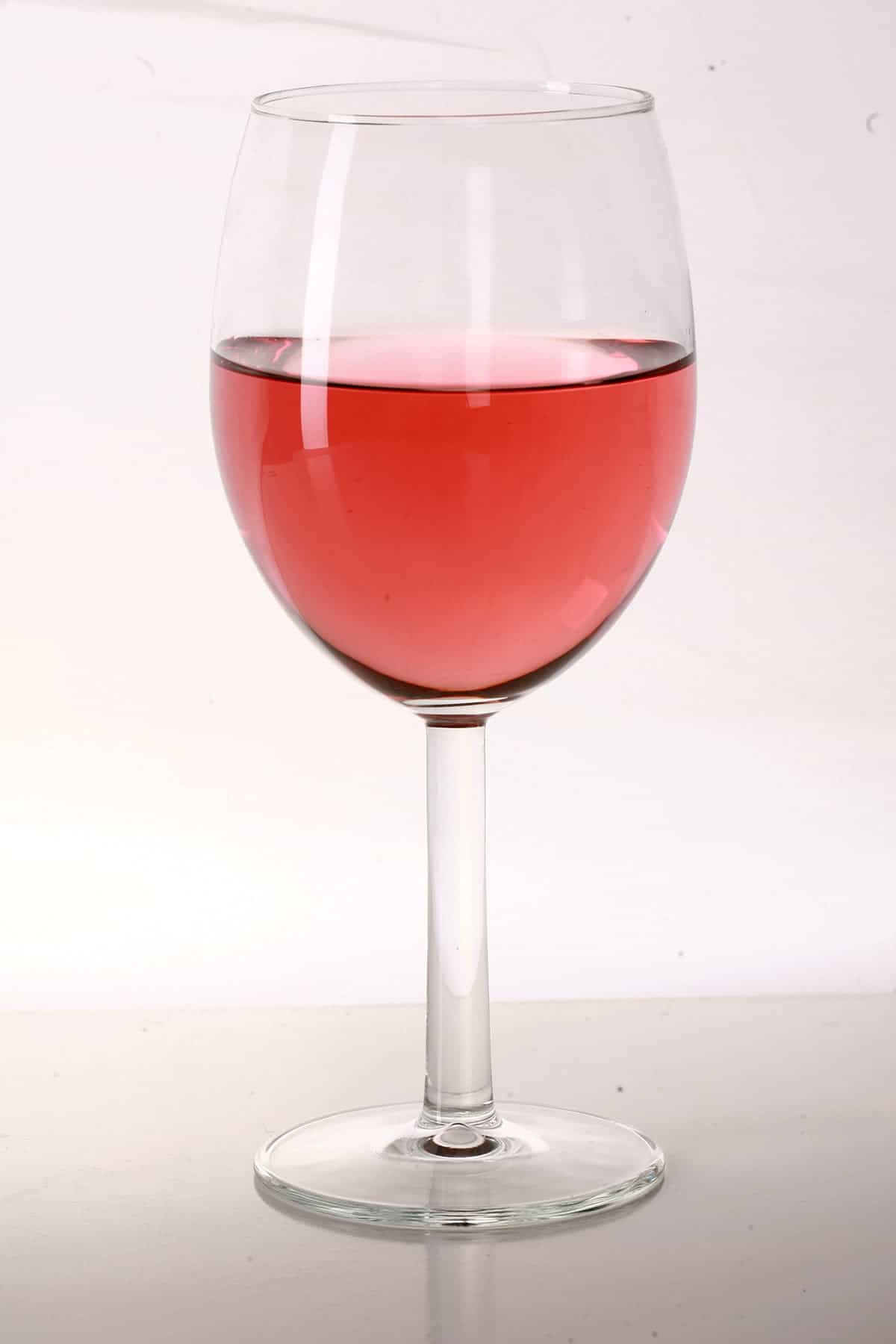
More Home Brewing Recipes!
While you've got your current homebrew fermenting away, why not consider putting a batch of something else on, to occupy your wait time? Here are a few of my other wine, cider, and mead recipes:
Wine Recipes
Banana Wine Recipe
Blackberry Wine Recipe
Blackcurrant Wine Recipe
Blueberry Wine Recipe
Cherry Wine Recipe
Cranberry Clementine Christmas Wine Recipe
Cranberry Wine Recipe
Faux Lingonberry Wine
Lychee Wine Recipe
Mango Strawberry Wine Recipe
Mango Wine Recipe
Mint Wine Recipe
Lychee Wine Recipe
Partridgeberry Wine Recipe
Passionfruit Wine Recipe
Peach Wine Recipe
Stone Fruit Wine Recipe
Ube Wine Recipe
Watermelon Wine Recipe
Mead Recipes
Black Cherry Mead Recipe
Blueberry-Clementine Mead Recipe
Blueberry Mead Recipe
Clementine Mead Recipe
Pumpkin Mead Recipe
Wildflower Mead Recipe
Cider & Miscellaneous Homebrew Recipes
Hard Apple Cider Recipe
Home Brew Hard Iced Tea Recipe
Maple Hard Apple Cider Recipe
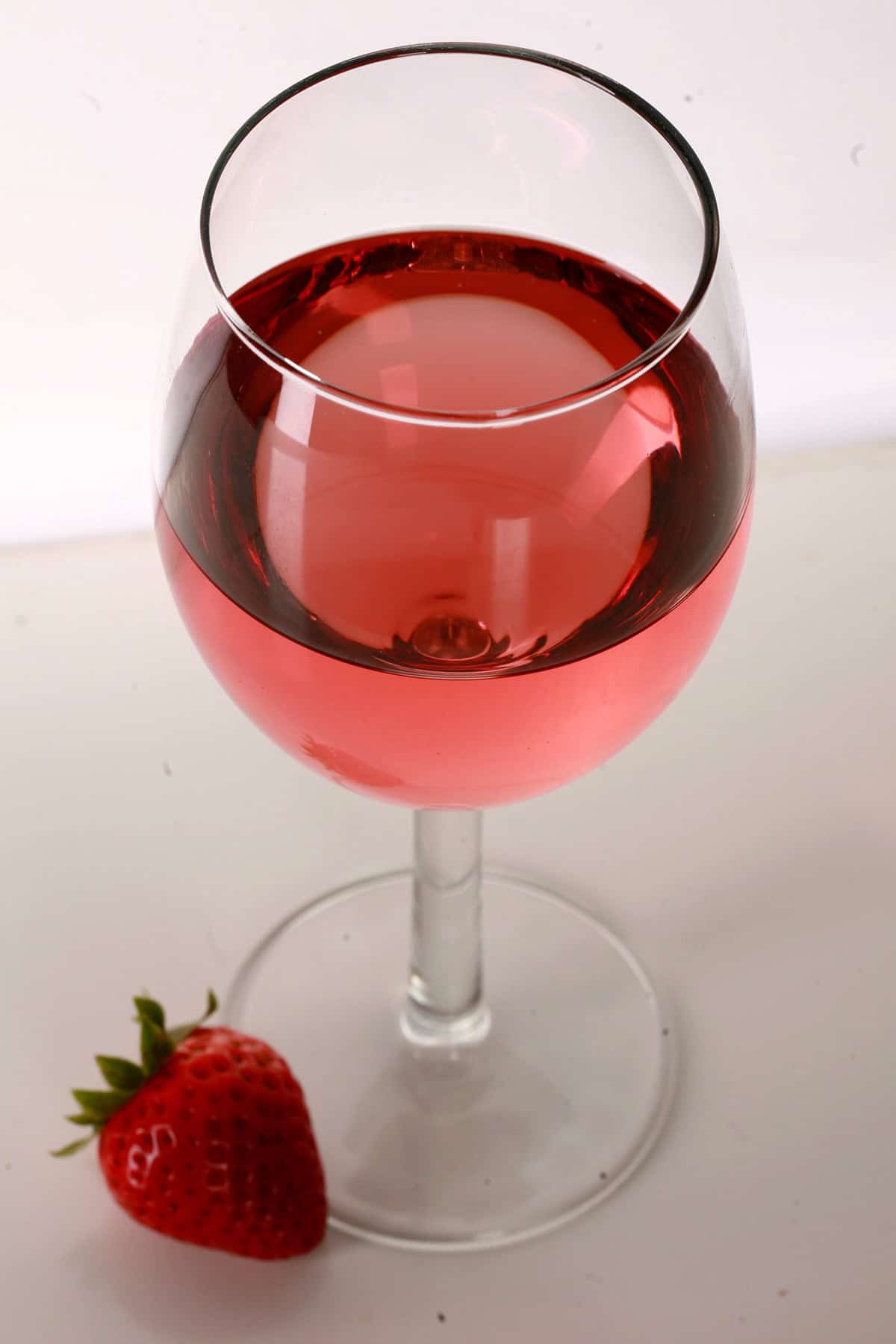
Share the Love!
Before you chow down, be sure to take some pics of your handiwork! If you post it to Bluesky, be sure to tag us - @CelebrationGen. We're also on Pinterest, so you can save all your favourite recipes to a board!
Also, be sure to subscribe to my free monthly email newsletter, so you never miss out on any of my nonsense. Well, the published nonsense, anyway!
Finally, if you love this recipe, please consider leaving a star rating and/or a comment below, and maybe even sharing this post on social media!
Homemade Strawberry Wine Recipe
Equipment
- 2 gallon fermenter bucket and lid
- 1 air lock and stopper
- Siphon, siphon tubing.
- 1 - 2 1 gallon glass carboys
Ingredients
- 6 lbs fresh strawberries*
- 3.5 lbs white sugar
- 1 gallon spring water
- 1 teaspoon yeast nutrient
- ½ teaspoon acid blend
- ½ teaspoon pectic enzyme
- ⅛ teaspoon wine tannin
- 1 packet Red Star “Cote de Blancs” yeast Or yeast of choice
- Wine stabilizer of choice optional
Instructions
- Rinse and pick through strawberries, removing any that are moldy, etc. Remove stems, chop them up.
- Place in a large pot, along with the sugar. Using a potato masher or VERY clean hands, stir and mash strawberries. Let sit for an hour.
- Add water, stir well. Heat to ALMOST boiling, then simmer gently for 30 minutes.
- Stir in acid blend, enzyme, nutrient, and tannin.
- Pour mixture into a freshly sanitized fermenting bucket. Cover with sanitized lid and air lock, allow to cool to room temperature (overnight).
- The next morning, give the mixture a quick stir with a long, sanitized spoon, and – using sanitized equipment – take a gravity reading of the liquid (strain out any strawberries). Keep track of the number! (This is an optional step, but will allow you to calculate your final ABV %)
- Sprinkle yeast into fermenter, cover with sanitized cover and air lock. Within 48 hours, you should notice fermentation activity – bubbles in the airlock, carbonation and /or swirling in the wine must. This means you’re good to go!
- After a week or so, use your sanitized siphon setup to rack the must into a freshly sanitized carboy. Put the carboy somewhere cool (not cold!), and leave it alone for a month or so.
- Using sanitized equipment, rack the wine off the sediment, into a clean, freshly sanitized carboy. Cap with sanitized airlock, leave it alone for another 2-3 months.
- Rack one more time, leave it for another 3 months or so.
- When your wine has been racked a few times and shows NO more fermenting activity for a month or so (no bubbles in the airlock, no more sediment being produced, you can move on to bottling. **
- If stabilizing, follow the instructions on your selected type of wine stabilizer to stop fermentation. For potassium sorbate, this needs to be done 2-3 days before bottling.
- Using sanitized equipment, take a gravity reading, then rack the wine into clean, sanitized bottles. Cork.







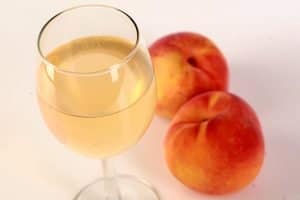
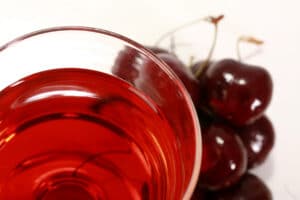
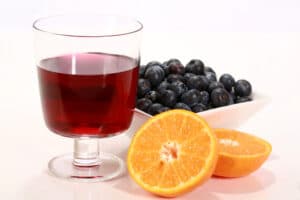

Michael
How much does this make it says a gallon of water. If using 6.5 gallon carboy is it ok to multiply by 5 or less? P.s. made Christmas wine turned out awesome thanks.
Marie Porter
When it starts out, it's about a gallon and a half, but after racking off the strawberries and sediment a few times, it ends up being about a gallon.
Yes, you can definitely multiply the ingredients, but use a bigger fermenting bucket (probably more like 7.5 gallons) for a 6 gallon batch. Also: You don't need to increase the yeast.
Morgan
Hi, Marie. My fiancé and I are thinking about making wine for wedding favors or to serve, but our wedding date keeps getting pushed back to the point that we don’t know when it’ll be. I was thinking about making your strawberry or watermelon wine, along with the blueberry or blackberry one, but I was wondering if they taste better aged longer or if they’re like some dandelion wines that get bitter the older they are?
Marie Porter
Hi Morgan,
Those ones are fine after several years. We've never kept any around more than 4 years or so, though, so I can't really speak to REALLY long term. I'd only be wondering about the strawberry and watermelon ones as a possible issue beyond the 4 years, though - the dark ones are generally great when aged longer.
Jen
Gday Mark. Brilliant write up! Am I correct in saying that this will be gracing my shelf for over a year before I’m able to enjoy? I am completely and utterly new to home brewing.
Marie Porter
You CAN drink it before 1 year, but it may be ... rough.
Chris
My wine turned out a little brownish. The taste is fine, but the color is definitely not like the pictures here.
Marie Porter
Might have been a matter of the variety of strawberries used - if something had actually gone wrong in making it, the taste would be awful!